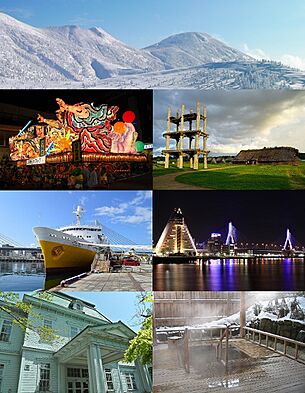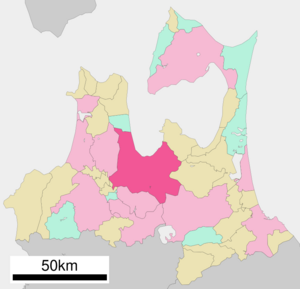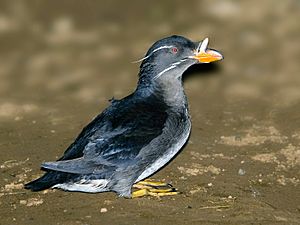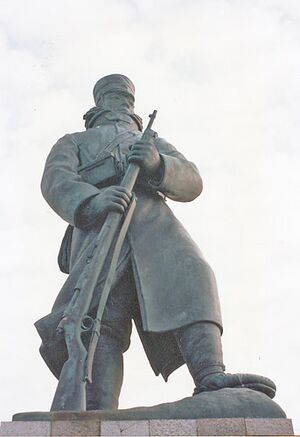Aomori facts for kids
Quick facts for kids
Aomori
青森市
|
|||||||||||||||
|---|---|---|---|---|---|---|---|---|---|---|---|---|---|---|---|
| Aomori City | |||||||||||||||

From top to bottom, left to right: The Hakkōda Mountains, Aomori Nebuta Matsuri, Sannai-Maruyama Site, Seikan Ferry Memorial Ship Hakkōda Maru, the waterfront of Aomori as seen from Aomori Bay, the Aomori City Forestry Museum, and Asamushi Onsen
|
|||||||||||||||
|
|||||||||||||||
 |
|||||||||||||||
| Country | |||||||||||||||
| Region | Tōhoku | ||||||||||||||
| Prefecture | |||||||||||||||
| Utō-mura | ? | ||||||||||||||
| Aomori-mura | 1626 | ||||||||||||||
| Aomori-machi | 1 April 1889 | ||||||||||||||
| Aomori-shi | 1 April 1898 | ||||||||||||||
| Area | |||||||||||||||
| • Core city | 824.61 km2 (318.38 sq mi) | ||||||||||||||
| Elevation | 0 to 1,584 m (0 to 5,197 ft) | ||||||||||||||
| Population
(1 August 2023)
|
|||||||||||||||
| • Core city | 264,945 | ||||||||||||||
| • Density | 321.2973/km2 (832.156/sq mi) | ||||||||||||||
| • Metro | 310,640 | ||||||||||||||
| Demonym(s) | Aomorian | ||||||||||||||
| Time zone | UTC+09:00 (JST) | ||||||||||||||
| Area code(s) | 02201-2 | ||||||||||||||
| Phone number | 017-734-1111 | ||||||||||||||
| Address | 1-22-5 Chūō, Aomori-shi, Aomori-ken | ||||||||||||||
| Expressways | |||||||||||||||
|
|||||||||||||||
Aomori (Japanese: 青森, Hepburn: Aomori, IPA: [aoꜜmoɾi]; lit. "Blue Forest"), officially called Aomori City, is the capital city of Aomori Prefecture in the Tōhoku region of Japan. As of August 2023, about 264,945 people live in Aomori. It is one of Japan's 62 core cities. This means it is an important city with more local control.
Contents
- Geography of Aomori
- Population of Aomori
- What Does Aomori Mean?
- History of Aomori City
- Economy of Aomori
- Education in Aomori
- Transportation in Aomori
- Sports in Aomori
- Parks and Recreation in Aomori
- Local Attractions in Aomori
- Sister Cities of Aomori
- Notable People from Aomori
- Images for kids
- See also
Geography of Aomori
Aomori is in the middle of Aomori Prefecture, which is the northernmost part of Honshu island. The city sits on the Aomori Plain and faces Aomori Bay to the north. To the south and east, you can see the Hakkōda Mountains.
Rivers and Nature in Aomori
Two main rivers, the Komagome River and the Arakawa River, flow through Aomori. Some parts of the city are inside Towada-Hachimantai National Park. This park is a popular place for tourists all year round. There are also many hot springs in the city, like Sukayu Onsen and Asamushi Onsen.
Aomori's Climate and Snowfall
Aomori has a humid climate with warm summers and cold winters. It is known for having some of the heaviest snowfall in the world. In February 1945, the snow reached a depth of 209 centimeters (about 82 inches)! This heavy snow happens because of winds that meet around the city, causing thick clouds and lots of snow.
In summer, a cool wind called "Yamase" can blow from the east. This sometimes makes the weather unusually cool and can affect harvests. Also, thick fogs from the Oyashio Current are often seen in the mountains during summer. These fogs can sometimes cause flights to Aomori Airport to be cancelled.
| Climate data for Aomori (1991−2020 normals, extremes 1882−present) | |||||||||||||
|---|---|---|---|---|---|---|---|---|---|---|---|---|---|
| Month | Jan | Feb | Mar | Apr | May | Jun | Jul | Aug | Sep | Oct | Nov | Dec | Year |
| Record high °C (°F) | 13.5 (56.3) |
19.4 (66.9) |
21.4 (70.5) |
28.3 (82.9) |
33.6 (92.5) |
33.5 (92.3) |
35.9 (96.6) |
36.7 (98.1) |
36.1 (97.0) |
30.5 (86.9) |
24.1 (75.4) |
21.1 (70.0) |
36.7 (98.1) |
| Mean daily maximum °C (°F) | 1.8 (35.2) |
2.7 (36.9) |
6.8 (44.2) |
13.7 (56.7) |
18.8 (65.8) |
22.1 (71.8) |
26.0 (78.8) |
27.8 (82.0) |
24.5 (76.1) |
18.3 (64.9) |
11.2 (52.2) |
4.5 (40.1) |
14.9 (58.8) |
| Daily mean °C (°F) | −0.9 (30.4) |
−0.4 (31.3) |
2.8 (37.0) |
8.5 (47.3) |
13.7 (56.7) |
17.6 (63.7) |
21.8 (71.2) |
23.5 (74.3) |
19.9 (67.8) |
13.5 (56.3) |
7.2 (45.0) |
1.4 (34.5) |
10.7 (51.3) |
| Mean daily minimum °C (°F) | −3.5 (25.7) |
−3.3 (26.1) |
−0.8 (30.6) |
4.1 (39.4) |
9.4 (48.9) |
14.1 (57.4) |
18.6 (65.5) |
20.0 (68.0) |
15.8 (60.4) |
9.1 (48.4) |
3.4 (38.1) |
−1.4 (29.5) |
7.1 (44.8) |
| Record low °C (°F) | −23.5 (−10.3) |
−24.7 (−12.5) |
−18.4 (−1.1) |
−12.2 (10.0) |
−1.4 (29.5) |
4.0 (39.2) |
6.5 (43.7) |
8.9 (48.0) |
3.0 (37.4) |
−2.4 (27.7) |
−12.1 (10.2) |
−20.6 (−5.1) |
−24.7 (−12.5) |
| Average precipitation mm (inches) | 139.9 (5.51) |
99.0 (3.90) |
75.2 (2.96) |
68.7 (2.70) |
76.7 (3.02) |
75.0 (2.95) |
129.5 (5.10) |
142.0 (5.59) |
133.0 (5.24) |
119.2 (4.69) |
137.4 (5.41) |
155.2 (6.11) |
1,350.7 (53.18) |
| Average snowfall cm (inches) | 195 (77) |
141 (56) |
64 (25) |
4 (1.6) |
0 (0) |
0 (0) |
0 (0) |
0 (0) |
0 (0) |
0 (0) |
23 (9.1) |
143 (56) |
567 (223) |
| Average precipitation days (≥ 0.5 mm) | 24.0 | 20.0 | 16.7 | 12.2 | 11.3 | 9.5 | 10.2 | 10.8 | 11.6 | 14.6 | 18.9 | 23.6 | 183.3 |
| Average relative humidity (%) | 78 | 76 | 70 | 65 | 71 | 78 | 80 | 78 | 76 | 73 | 73 | 78 | 75 |
| Mean monthly sunshine hours | 48.5 | 72.3 | 126.0 | 179.1 | 201.4 | 180.0 | 161.4 | 178.0 | 162.4 | 144.4 | 85.4 | 50.4 | 1,589.2 |
| Source: Japan Meteorological Agency | |||||||||||||
Population of Aomori
People who live in Aomori are called Aomorians. The number of people living in Aomori has stayed about the same over the last 40 years.
| Historical population | ||
|---|---|---|
| Year | Pop. | ±% p.a. |
| 1920 | 48,941 | — |
| 1930 | 77,103 | +4.65% |
| 1940 | 99,065 | +2.54% |
| 1950 | 106,417 | +0.72% |
| 1960 | 235,116 | +8.25% |
| 1970 | 261,743 | +1.08% |
| 1980 | 309,768 | +1.70% |
| 1990 | 308,782 | −0.03% |
| 2000 | 318,732 | +0.32% |
| 2010 | 299,520 | −0.62% |
| 2020 | 275,340 | −0.84% |
| 2023 | 264,945 | −1.27% |
What Does Aomori Mean?

The name Aomori means "blue forest" or "green forest". It is thought to come from a small forest on a hill that fishermen used as a landmark. The city's original name was Utō, named after the Rhinoceros auklet (ウトウ), a seabird like a puffin. The name changed to Aomori in 1626, but it took a while for everyone to use it.
History of Aomori City
People have lived in the Aomori area for a very long time. Archaeologists have found many ancient sites from the Jōmon period. The most famous is the Sannai-Maruyama Site, which is about 5,500 to 4,000 years old. These large ancient villages changed how we think about early civilizations in Japan.
Aomori's Development as a City
Aomori started as a small port village. In 1626, it was rebuilt and renamed "Aomori." In 1871, Aomori became the capital of Aomori Prefecture. It officially became a town in 1889 and then a city in 1898.
Aomori grew a lot because it became a major transportation hub. In 1872, a ferry service started connecting Aomori to Hakodate in Hokkaido. The city also got connected to Tokyo by train in 1891 with the Tōhoku Main Line. The Seikan Ferry officially opened in 1908, making Aomori an even more important link between Honshu and Hokkaido.
Modern Aomori
In 1910, a big fire burned down much of the town. Later, during World War II, Aomori was heavily damaged by air raids in July 1945. However, the city was rebuilt after the war and became a strong local center for business and government.
In 1988, the Seikan Tunnel opened, which is an underwater railway tunnel. This tunnel took over the ferry's role as the main way to travel between Honshu and Hokkaido. In 2002, Aomori was named a "core city," giving it more power to manage its own affairs. In 2005, the town of Namioka joined Aomori, making the city even bigger.
Economy of Aomori
Aomori is the main business center for its region. Most of the city's economy comes from the service sector, which makes up about 78% of its business. Manufacturing is about 16%, and agriculture and fishing make up about 4%.
Education in Aomori
Aomori has many schools. The city government runs 45 public elementary schools and 19 public junior high schools. There are also private junior high schools. For older students, there are 10 public high schools and three private high schools. The prefecture also has special education schools for students with disabilities.
Universities and Colleges in Aomori
- Aomori Public University
- Aomori University of Health and Welfare
- Aomori University
- Aomori Chuo Gakuin University
Transportation in Aomori
Aomori is a key transportation hub, connecting different parts of Japan.
Aomori Airport
Aomori Airport opened in 1964. It has daily flights to major Japanese cities like Tokyo and Osaka. Since 1995, it also has international flights to places like Seoul, South Korea, and Tianjin, China. The airport is about a 35-minute drive from the city center.
Railways in Aomori
Aomori Station has been the city's main train station since 1891. It was the end point for major train lines connecting to Tokyo and other cities. From Aomori Station, people used to take the Seikan Ferry to Hokkaido.
In 2010, the Tōhoku Shinkansen (bullet train) opened a new station called Shin-Aomori Station. This high-speed train connects Aomori to Tokyo and other big cities quickly.
 East Japan Railway Company (JR East) – Tōhoku Shinkansen
East Japan Railway Company (JR East) – Tōhoku Shinkansen
- Shin-Aomori
 JR East – Ōu Main Line
JR East – Ōu Main Line
- Aomori - Shin-Aomori - Tsugaru-Shinjō - Tsurugasaka - Daishaka - Namioka
 JR East – Tsugaru Line
JR East – Tsugaru Line
- Aomori - Aburakawa - Tsugaru-Miyata - Okunai - Hidariseki - Ushirogata - Nakasawa
 Aoimori Railway Line
Aoimori Railway Line
- Aomori - Higashi-Aomori - Koyanagi - Yadamae - Nonai - Asamushi-Onsen
Highways in Aomori
Aomori is connected by several important highways:
 Tōhoku Expressway – Tōhoku Expressway
Tōhoku Expressway – Tōhoku Expressway Aomori Expressway – Aomori Expressway
Aomori Expressway – Aomori Expressway National Route 4
National Route 4 National Route 7
National Route 7 National Route 103
National Route 103
Seaports in Aomori
The Port of Aomori is where ferries operate. The Seikan Ferry and Tsugaru Kaikyō Ferry travel to Hakodate. The ferry ride takes about four hours. Before the Seikan Tunnel opened in 1988, these ferries were the main way to travel between Honshu and Hokkaido.
Sports in Aomori
Aomori is known for curling. It has hosted several international curling events, including the 2003 Asian Winter Games. The local women's team, "Team Aomori," represented Japan at the 2006 Winter Olympics and the 2010 Winter Olympics. In 2007, Aomori also hosted the World Women's Curling Championships.
Sports Facilities in Aomori
- Aomori City Baseball Stadium (Gappo Park Stadium)
- Aomori Stadium
- Aomori Velodrome
Parks and Recreation in Aomori
Gappo Park is the oldest public park in Aomori. It has a public beach, water gardens, and the Aomori City Baseball Stadium. Other parks include Aoimori Park and Nogiwa Park.
Local Attractions in Aomori
The Aomori Nebuta Matsuri is a very famous festival held every year from August 2nd to 7th. It's known for its huge, colorful lantern floats. The festival is so special that it's listed as one of the "100 Soundscapes of Japan."
Besides the festival, Aomori has many interesting places to visit:
- Aomori Bay Bridge
- Aomori Museum of Art
- Asamushi Aquarium
- Asamushi Onsen (hot spring)
- Komakino Site, an important ancient historical site
- Nebuta Museum Wa Rasse, where you can learn about the Nebuta festival
- Sannai-Maruyama Site, a very important prehistoric village site
- Sukayu Onsen (hot spring)
Sister Cities of Aomori
Aomori has special connections with several cities around the world:
 Hakodate, Japan – They share a "twin cities" relationship.
Hakodate, Japan – They share a "twin cities" relationship. Kecskemét, Hungary – since 1994.
Kecskemét, Hungary – since 1994. Pyeongtaek, South Korea – since 1995.
Pyeongtaek, South Korea – since 1995. Dalian, China – since 2004.
Dalian, China – since 2004. Hsinchu County, Taiwan – a friendship city since 2014.
Hsinchu County, Taiwan – a friendship city since 2014.
Notable People from Aomori
Many talented people come from Aomori, including:
- Noriko Awaya, a singer
- Takaharu Furukawa, an archer
- Daisuke Matsuzaka, a famous baseball player
- Shiko Munakata, a woodblock artist
- Hitoshi Saito, a judoka
- Shūji Terayama, a modern artist
- Akiko Yano, a singer-songwriter
Images for kids
See also
 In Spanish: Aomori (Aomori) para niños
In Spanish: Aomori (Aomori) para niños










